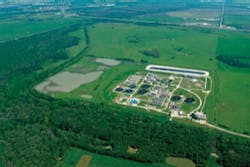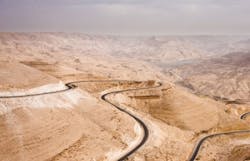Automatic Caustic Dosing Reduces Wastewater Plant's Costs
By Bob Dabkowski
Improved performance, meeting compliance with strict ammonia limits, and chemical expenditure reductions of more than $100,000 annually have been the major benefits achieved from adopting real-time ammonium monitoring at the Mallard Creek Wastewater Treatment Plant, one of five wastewater operations serving the Charlotte, NC, area. With the installation of new, advanced sensors, the plant is now continuously monitoring seasonal and daily variations in ammonium, thereby allowing it to control caustic dosing for optimum ammonia reduction.
Charlotte-Mecklenburg Utilities serves more than 774,000 customers in the City of Charlotte and greater Mecklenburg County. The utility's five wastewater treatment plants have a combined capacity of 123 million gallons per day. The Mallard Creek plant is an activated sludge plant that includes complete nitrification. The 12 mgd treatment plant also serves as a water reclamation facility, providing 300,000 to 400,000 gallons per day of reclaimed water to a local golf course and public park.
The Mallard facility has 1.0 ppm/summer and 2.0 ppm/winter ammonia discharge limits. Caustic is fed during nitrification as an additional alkalinity source to supplement the low alkalinity wastewater, since the nitrification process consumes alkalinity. Although the plant was meeting its ammonia limit, Plant Supervisor Darrell DeWitt was concerned about plant efficiency, especially with rising chemical costs.
"We knew ammonia levels changed from summer to winter in our biological treatment and I wanted to precisely track when that shift occurred, and at what temperature," DeWitt said. "I also wanted to see how the ammonia was trending with sidestreams."
On-Line Monitoring
To track ammonia levels, the Mallard Creek plant installed, on a trial basis, a new sensor to monitor ammonium. The on-line sensor was placed in the center of one of the plant's three aeration basins. A conversion factor is used to convert ammonium measurements to ammonia measurements. Readings from the probe revealed shifts in ammonia levels at certain changes in temperature. Based on this initial trial, the plant acquired three of the new ammonium sensors, installing one in each aeration basin.
The Hach NH4D sc ammonium sensors selected for the trial use an ion-selective electrode (ISE) to detect ammonium ions (NH4+) directly in the aeration basin as ammonium nitrogen (NH4-N). A differential pH reference electrode is used as the reference electrode for the NH4Dsc sensor. The most significant potential interference in wastewater matrices is from potassium ions. The NH4D sensor compensates by using an integrated potassium ISE to correct the ammonium value. Potential interferences are further reduced using Cartrical™ technology, which calibrates each electrode individually and calibrates all three electrodes to each other. The instrument also includes a temperature sensor to further improve accuracy.
"The sensors enabled us to clearly identify significant changes with our nitrification from winter to summer," DeWitt said. "The probes detected no ammonia during the summer months. In the winter months, however, ammonia levels in our aeration tanks rose as high as 2.0 to 5.0 ppm.
"We determined from the probe data that this shift was occurring when the water temperature dipped to 19 degrees and below. Pinpointing this shift has allowed us to more accurately determine and troubleshoot our SRTs (sludge retention times) to improve performance."
Ammonia Fluctuations
In addition to identifying ammonia seasonal temperature variations, DeWitt said the probe readings also indicated a daily fluctuation in ammonia levels, regardless of seasonality or temperature.
"The probe readings showed ammonia peaking at different times of the day. We were consistently seeing daily fluctuations, not just seasonal fluctuation," he said.
Based on this initial indication, DeWitt elected to further investigate, with the aim of potentially improving caustic feed based on real-time data from on-line ammonium measurement. A Hach NH4D probe was installed just before the activated sludge process to measure influent ammonia. There, the probe confirmed wide daily fluctuations in influent ammonia loadings.
"Every day, between 5 to 6 a.m. our ammonia levels are 20 to 24 ppm. Around 9 a.m. to 10 a.m., we start seeing levels climb. Then it peaks anywhere from 1 p.m. to 3 p.m., with levels climbing as high as 40 ppm," he said. "By evening between 7 p.m. to 9 p.m. ammonia levels start to drop back to 20 to 24 ppm. We were not aware of these trends until we installed the probes."
Re-Evaluating Fixed-Rate Dosing
Despite these fluctuations in ammonia influent loadings, the plant had been feeding caustic at a fixed dosage rate based on periodic grab sample results and flow pacing. Feed rates were adjusted on the high side to ensure ample alkalinity for nitrification and proper pH in the effluent.
"From what the ammonium probe was telling us, it was apparent we were overfeeding caustic several hours each day at this fixed rate," DeWitt said.
Based on this new information, the plant installed variable frequency drives (VFDs) on its chemical metering pumps and then linked the signal from the ammonium probe to the plant SCADA system using a 4-20 mA output from the probe's sc100 Controller. The SCADA system calculates and adjusts caustic flow rate to consistently meet the desired set-point based on real-time influent ammonia loadings.
The switch to automatic chemical feed based on real-time ammonium levels has so far reduced annual caustic use by approximately 30 percent, according to DeWitt. From July 2007 to June 2008 (FY2008), the plant used about 423,000 gallons of caustic. This last fiscal year, from July 2008 to June 2009, the plant used 300,000 gallons.
Prior to FY2008, caustic was running about $0.61 a gallon. But in FY2008, the industry saw the price of caustic nearly double, jumping to $1.11 a gallon. The Mallard Creek facility had not budgeted for that cost increase.
"From the first day of the budget year, I was already way in the hole, due to the increase cost of caustic," DeWitt said. "But by October, with our automatic feed system in place, we were able to get back $150,000. That was huge, and our new ability to accurately measure ammonia in real-time did that for us."
To ensure optimum performance of its ammonium sensors and other instrumentation, Mallard Creek entered into a Field Service Partnership with the manufacturer. Under the program, Hach technicians conduct preventive maintenance on the probes and other instruments according to standard factory recommended schedules. They also calibrate and certify the instruments on every visit, and ammonium sensor cartridges are changed as needed. According to DeWitt, having the probes routinely serviced is one less thing that plant personnel have to do, enabling them to focus on other priorities at the plant.
While the prices of caustic have since dropped to below 2007 levels, DeWitt said he expects to see the plant's caustic usage cut even more – by 40 to 45 percent – due to the performance of the sensors.
"Even with caustic's current low price of $0.47 a gallon, our plant is still saving at least $100,000 annually. Should the price again go back up to $1.11 a gallon, we could realize annual savings of $200,000," he said.
Due to increasingly stringent regulations and the need for greater operating efficiencies, wastewater treatment plants must continually be prepared to change in order to maintain a high level of optimization. For the Mallard Creek plant, the addition of on-line ammonium sensors has brought optimization to nitrification and caustic feed.
"With continuous, real-time data we can now adjust and significantly improve our processes daily. We now have the necessary information and tools to help us year-round," DeWitt said. WW
About the Author:Bob Dabkowski is a Wastewater Specialist for Hach Company and a Licensed Colorado Wastewater Operator. He is the author of several papers, articles, and application notes concerning wastewater treatment and has over eight years experience at Hach, advising process control & automation solutions. He may be contacted via e-mail at [email protected].



